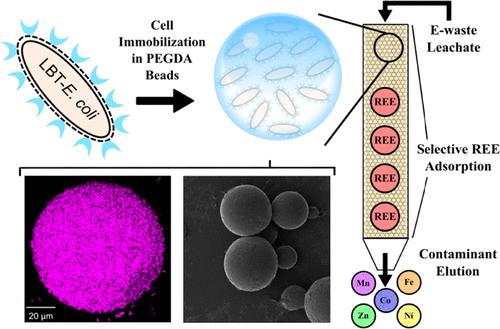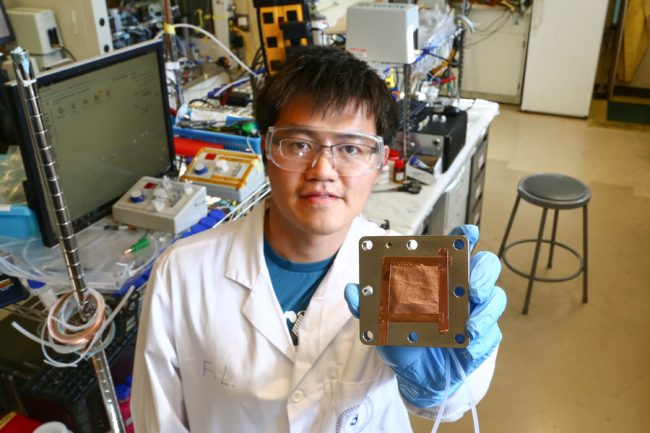(LLNL researchers turn to microbe beads to increase U.S. supply of rare earth metals)
2019/11/25 アメリカ合衆国・ローレンスリバモア国立研究所 (LLNL)

・ LLNL が率いる Critical Materials Institute の研究チームが、微生物(E.Coli)を埋め込んだポリマーのビーズを利用して、電子製品のライフサイクル終了時にネオジム(NdFeB)磁石から希土類金属(REEs) のネオジムを回収する技術を開発。
・ 同ビーズは、材料科学と微生物学の統合により創出されたスケーラブルなバイオ吸着材料。ネオジムやジスプロシウムのような REEs は、太陽光・風力発電技術やスマートフォン等の電子製品において不可欠なもの。
・ 風力タービン、ハイブリッド車、EV、コンピューターの HDD 等で使用される NdFeB 磁石は、例えば携帯電話では 2~3 年、風力タービンでは 20~30 年のように、アプリケーションによってライフサイクルが異なる。ライフサイクル終了後の製品のこのような磁石からの REEs 回収は、将来の REEs の総供給量において重要で補完的な役割を担うと考える。
・ REEs の産出とそれらを利用した製品のライフサイクル終了後のリサイクルが米国内に限られている現状の打破を目指し、省エネで環境的に持続可能な生物吸着による REEs 抽出技術を開発。REEs はハイテク経済と国家安全保障にとって重要なデバイスに使用されるため、クリーンエネルギー産業における米国の競争力の維持に最も重要。
・ 透過性のポリエチレングリコールジアクリレート(PEGDA)ハイドロゲルに E.Coli を埋め込んだ同微生物ビーズは、電気電子機器廃棄物フィードストックの浸出水から選択的に REEs を抽出。同ビーズは再利用可能で、現時点では連続吸着・脱着の 9 サイクル後も吸着能力を維持。微生物バイオマスの利用による産業用希土類回収に大きな影響を及ぼす技術と考える。
・ 微生物は成長・増殖に伴って高密度の表面官能基を合成し、複雑で高コストな化学合成のステップ無しで大容量の REE 吸着を促進する。一般的に非 REEs 金属イオンよりも REEs を選好して吸着し、表面に吸着された REEs は脱着により迅速に回収できる。
・ 本研究は、米国エネルギー省(DOE)のエイムズ国立研究所が率いる DOE イノベーションハブの Critical Materials Institute (CMI)の一環であり、DOE のエネルギー効率・再生可能エネルギー局 (EERE)の先進製造業室が支援した。
URL: https://www.llnl.gov/news/llnl-researchers-turn-microbe-beads-increase-us-supply-rareearth-metals
(関連情報)
Environmental Science and Technology 掲載論文(アブストラクトのみ:全文は有料) Microbe Encapsulation for Selective Rare-Earth Recovery from Electronic Waste Leachates
URL: https://pubs.acs.org/doi/10.1021/acs.est.9b04608
<NEDO海外技術情報より>
Abstract
Rare earth elements (REEs) are indispensable components of many green technologies and of increasing demand globally. However, refining REEs from raw materials using current technologies is energy intensive and enviromentally damaging. Here, we describe the development of a novel biosorption-based flow-through process for selective REE recovery from electronic wastes. An Escherichia coli strain previously engineered to display lanthanide-binding tags on the cell surface was encapsulated within a permeable polyethylene glycol diacrylate (PEGDA) hydrogel at high cell density using an emulsion process. This microbe bead adsorbent contained a homogenous distribution of cells whose surface functional groups remained accessible and effective for selective REE adsorption. The microbe beads were packed into fixed-bed columns, and breakthrough experiments demonstrated effective Nd extraction at a flow velocity of up to 3 m/h at pH 4–6. The microbe bead columns were stable for reuse, retaining 85% of the adsorption capacity after nine consecutive adsorption/desorption cycles. A bench-scale breakthrough curve with a NdFeB magnet leachate revealed a two-bed volume increase in breakthrough points for REEs compared to non-REE impurities and 97% REE purity of the adsorbed fraction upon breakthrough. These results demonstrate that the microbe beads are capable of repeatedly separating REEs from non-REE metals in a column system, paving the way for a biomass-based REE recovery system.



